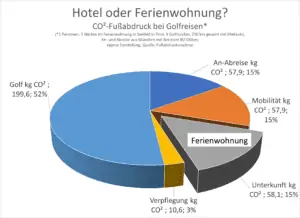Better CO₂ footprint for golf trips
The CO₂ footprint of golf trips varies greatly per person depending on the destination, the type of arrival and departure, and the choice of accommodation. If you travel to the nearest state or a neighboring state by car, the CO₂ balance accounts for a relatively small proportion of the overall balance. For long-distance destinations, on the other hand, the journey to and from the destination accounts for the largest part and the carbon footprint quickly becomes much larger.
According to tour operators, carbon footprint issues are not yet having a noticeable impact on travel behavior. The golfer has a desire to play courses he does not know yet. On the other hand, air travel doesn’t have the best reputation when it comes to CO₂ emissions, and the Gulf cruise isn’t really a gift for the environment either. On the other hand, even small measures can save emissions. A 5-star hotel with large rooms, spa and fitness room has a significantly higher footprint than a guesthouse or vacation apartment.
Seefeld or Mauritius?
An overview with practical examples calculated with four different starting points (Munich, Hamburg, Vienna, Zurich) and three destinations (Seefeld in Tyrol, Mallorca and Mauritius) using the CO2 calculator of Graz University of Technology. This is the only one of all calculations known to us that also contains a round of golf as a value. Unfortunately, TU Graz did not give an answer even to several inquiries, from which points exactly the value for this round of golf is composed.
The results of the trips to different destinations are broken down into five categories (travel to and from the destination, local mobility, accommodation, meals and golfing).

Arrival and departure
Two examples illustrate quite well how different arrivals and departures influence CO₂ values:
Emissions of a five-day vacation for two people: Travel in a passenger car (gasoline) from Vienna to Seefeld. Five nights in a 5-star hotel and four rounds of golf per person. Within the city, 50 km are covered daily. Footprint per person: 915.4 kg CO₂ (accommodation 415.7 kg, catering 10.6 kg, golf 199.6 kg, travel to and from 231.6 kg and mobility on site 57.9 kg)
Compared to the first example, the same trip in the ICE from Vienna to Seefeld causes more than half less emissions (just under 45 percent of them).
Air travel does take higher emission levels than other modes of transportation in some of the selected examples, but not always necessarily. After measuring the air line between the starting airport and the nearest destination airport plus transfer to the golf course for further distances, the total kilometers for arrival and departure can sometimes be significantly less than the distance by car (for example, a total of 400 km less from Hamburg to Seefeld and back).
More luxury in the hotel means more emissions
It gets even more CO₂-friendly if you swap the 5-star hotel for a vacation apartment: five nights in the apartment and four rounds of golf per person: 50 km are covered daily in a rental car within the city. Footprint per person: 403.2 kg CO₂ (accommodation 58.1 kg, catering 10.6 kg, golf 199.6 kg, travel to and from the event 77 kg and mobility on site 57.9 kg)
In the case of nearby travel destinations, travel to and from the destination by car accounts for between six percent (Munich; 44.5 kg) and 39 percent (Hamburg; 444.6 kg) of the overall balance, depending on the starting point. The greater the distance, the greater this proportion becomes. For trips to Majorca, this proportion is still less than half (between 36 and 49 percent; 390 – 645 kg), but for air travel to Mauritius, this category clearly has the highest proportion, between 70 and 72 percent (2,282 kg to 2,386 kg). For long-haul destinations such as Mauritius, the total weight per person increases rapidly (between 3,120 kg and 3,313 kg)

Accommodation and catering
The type of accommodation also takes a high priority, as the following example illustrates.
Flight from Vienna to Palma de Mallorca. Five nights in a four-star hotel and four rounds of golf per person. On the island, a total of 250 km will be covered by rental car. Footprint per person: 1104.7 kg CO₂ (accommodation 232.6 kg, food 10.6 kg, golf 199.6, round trip 604.0 kg, on-site mobility 57.9 kg).
Flight from Hamburg to Mauritius. Five nights in a five-star hotel and four rounds of golf per person. On the island, a total of 250 km will be covered by rental car. Footprint per person: 3,313 kg CO₂ (accommodation 658.7 kg, food 10.6 kg, golf 199.6, round trip 2,386.3 kg, on-site mobility 57.9 kg).
Regardless of the destination, the percentages differ greatly for accommodation. While a 5-star hotel, in the example of Seefeld with 415.7 kg (between 39 percent and 59 percent of the total balance) has a relatively high value, the value is reflected much less in the CO₂ balance for a vacation apartment (in Seefeld: 58.1 kg; depending on the starting point between 8 and 17 percent).
The values calculated in the footprint calculator of Graz University of Technology for catering, which were calculated in the above examples with non-vegetarian meals, account for values of a maximum of 3 percent of the total balance.


Mobility and golf
Local mobility, which is included in the above examples in the form of a rental car (gasoline), also comes off relatively lightly with a value of 57.9 kg and is between 2 and 15 percent of the total balance in percentage terms.
An example: flight from Zurich to Mallorca. Five nights in a five-star hotel and four rounds of golf per person: On the island, a total of 250 km are covered by rental car. Footprint per person: 1,073.7 kg CO₂ (accommodation 415.7 kg, food 10.6 kg, golf 199.6, round trip 390 kg, on-site mobility 57.9 kg)
The fifth category, golf, must not be forgotten when it comes to the CO₂ balance. At 199.6 kg for four rounds of golf, this is relatively high and has shares of between 18 and 28 percent there, depending on the mode of transport chosen for arrival and departure.







